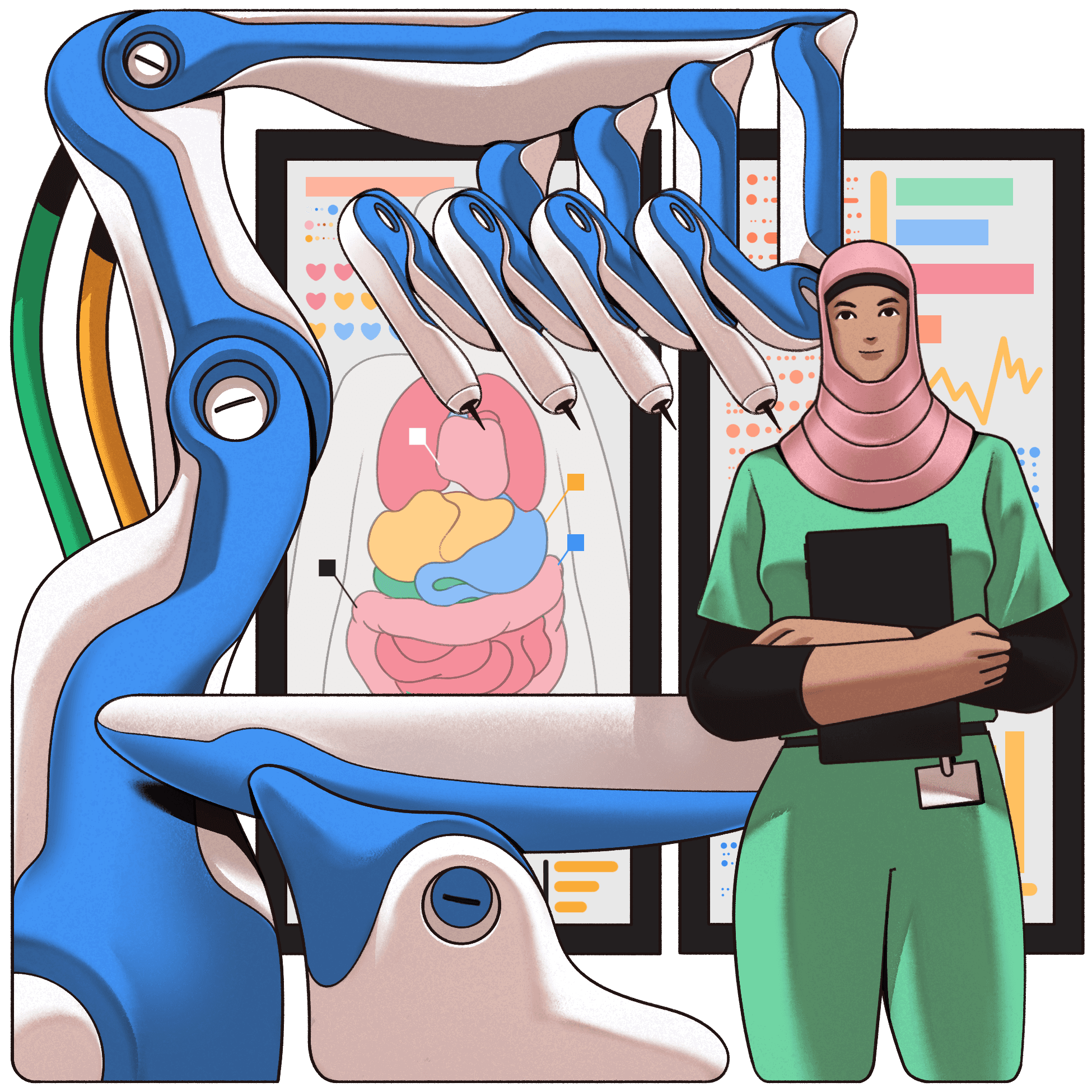Hospitals of the Future
Picture this: You’re sitting at your desk when your phone pings. A text alert reveals anomalies in the bloodwork your doctor ordered at your last checkup. You see in your patient portal that you’ve already been scheduled for a follow-up visit at a nearby hospital—and your parking space has been reserved.
After you enter the hospital lobby through an inconspicuous security checkpoint, your phone buzzes again:
As you make your way to the appropriate waiting room, you pass several pieces of nature-inspired wall art; landscaped courtyards for patients, staff, and visitors; and signs directing visitors to the bright and airy behavioral health wing nearby. Continuing on, you spot a security dog and its handler, as well as the entrance to a swanky lounge where nurses, doctors, and other frontline staff can collaborate, grab lunch, or even take a nap.
Once you reach the right suite and take a seat, sensors notify the doctor and nurses of your arrival. Your smartphone alerts:
Following additional tests, your doctor determines that surgery is needed. The surgical team—including a physician located 500 miles away—will practice the tricky procedure on a 3D-printed model of your heart; later, they’ll project a live feed of what’s happening inside your chest cavity onto your body in the operating room.
You recover from the procedure in a room that has cameras and tablets so you can communicate with your health team, family members, and even other patients—freeing up nurses to tend to patients who need hands-on care first. Meanwhile, biosensors continuously track and notify medical providers of your recovery progress even after you’ve been discharged, lessening your risk for infection and other adverse events.
The scenario, experts told Healthcare Brew, is what they expect for the future of hospital care. And with some of that technology—or early versions of it—around today, this future may not be too far off.
“There’s easily a way that we can cater the [hospital] experience in a much more proactive way than we are now, to the point where we have the ability for every journey of a patient to be unique and different, and specialized to who they are—[no matter] what socioeconomic class they are, what age they are, all those kinds of things,” said Mike Pukszta, a codirector of CannonDesign’s global health practice. “In 10 to 15 years, that’s going to be state of the art. That’s going to be how everything is done.”
Hospitals of today offer more than just care for the sickest of patients: They’re major economic hubs for their communities and employ thousands of workers—and they’re often the largest employer in their region.
The hospital of the future is no different.
Beyond providing care, the hospital is expected to take its role in the community a step further by encouraging visitors to take advantage of on-site green spaces and restaurant offerings, or to maybe pick up a gift on the way out—but not before grabbing a flu shot.
Through this story of the hospital’s evolution, we are illustrating how the industry is transforming amid new technological advances, staffing challenges, and greater patient autonomy.
—Shannon Young
Physical footprint
Advances in technology and the growing focus on outpatient care has transformed the physical layout and size of hospital buildings in recent decades—and that trend doesn’t look like it’s going to slow down. The hospital of the future is expected to feature seamless technology integrations that allow for a curated and highly personalized end-to-end patient experience.
Operating rooms are already changing from using strictly surgical instruments to utilizing imaging and other technologies to improve surgery outcomes. Meanwhile, inpatient behavioral health units are embracing designs that promote mental wellness, like access to green spaces and art. And advancements in new remote monitoring technologies is expected to lead to shorter inpatient stays.
How new technology is reshaping hospital operating suites
New high-tech robotics and imaging devices offer a preview of the OR of the future.
How health systems are trying to reduce their carbon footprints
Health systems are deploying strategies from eliminating certain anesthetic gasses to vegan-izing their menus.
Staffing
With longstanding nurse and physician shortages not expected to abate anytime soon, staffing—and strategies to address the issue—is top of mind for many healthcare executives as they design their hospitals of the future. For some, that has resulted in a greater focus on retention, and efforts to address it include adding new employee spaces that go beyond the traditional, segregated break room by encouraging collaboration (along with perks like sleeping pods). Others, meanwhile, are looking at how they can better protect staff amid rising rates of violence against healthcare workers.
What the nursing workforce of the future could look like
Technology is shaping the future of the nursing profession.
Sleep pods, coffee bars, and coworking spaces: Hospital staff lounges get a makeover
How hospitals are rethinking employee break rooms.
The C-Suite
The Covid-19 pandemic accelerated change in many facets of healthcare, from the supply chain to how hospital marketers communicate with patients. Looking to the future, chief supply chain officers aim to focus on bringing in technology that both makes their health system supply chains more efficient and mitigates shortages like those seen during the pandemic. Programs like 340B continue to play an important role in ensuring hospitals are able to treat Medicaid, Medicare, and uninsured patients. And chief marketing officers are looking to use technology to precisely tailor communications to patients. Meanwhile, CEOs want to take hospital innovations a step further as they embrace the hospital of the future.
The hospital of the future will look different and deliver care in new ways
C-Suite executives shared their visions for the future of healthcare.
What does the future of the healthcare supply chain look like?
Tech will play an increasingly important role in managing healthcare supply chains, experts anticipate.
What the future holds for the 340B drug pricing program
It’s an uncertain road ahead for the federal program.
The future of hospital marketing
Nontraditional media, artificial intelligence, and personalization define the future of hospital marketing.
Credits










